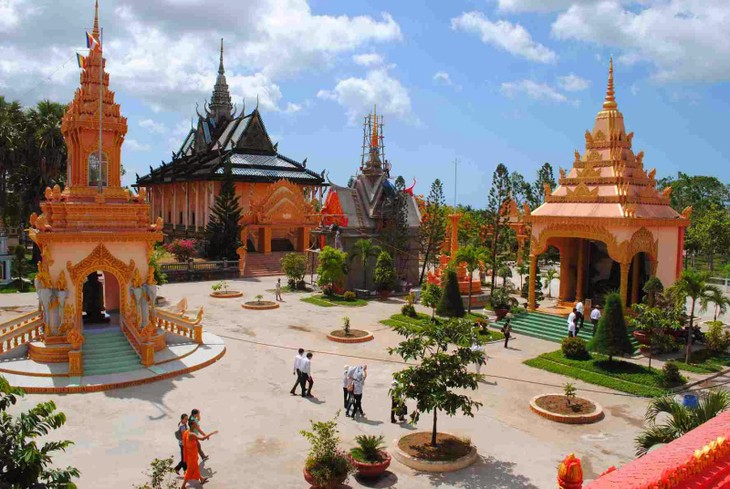(VOVworld) – The Khmer are Buddhist followers and they build pagodas wherever they live. Pagoda is not purely a religious place but also a school for children and a venue for people to share production knowledge. Pagodas have played an important part in spreading and preserving the Khmer culture.
 |
| Xiem Can pagoda in Can Tho |
The Khmer pagoda is a community venue that is similar to the communal house of the Kinh majority and the Rong house of ethnic groups in the Central Highlands. Khmer men have to live and study in pagodas before they go to school. They have to study in pagodas to be recognized by society. Wedding and funeral ceremonies must have the attendance of monks. The Khmer worship their ancestors in pagodas.
The Khmer pagoda preserves sacred Buddhist Sutras and cultural documents. The Khmer consider the pagoda their second home. Nguyen Hung Vi is a folklorist: “For the Khmer, the pagoda is a sacred place but very close to their lives. They often go to pagodas to ask monks for advice. Pagodas are as important as their houses.”
 |
| Ghositaram pagoda in Bac Lieu province |
A Khmer pagoda has a spacious yard, curved roofs, and a high tower to symbolize the sacred summit where the genies reside. Associate Professor, Doctor Lam Ba Nam is from the Hanoi National University of Social Sciences and Humanities. “Khmer pagodas have a typical architecture. In a Khmer village, the pagoda is built on a high land and stands out from other construction works. It’s the architectural style of the Khmer Theravada Buddhism.”
Pagoda roofs are engraved with images of the Naga, taking the form of a cobra with several heads. The three-head Naga represents the heaven, the earth, and human. The 5-head Naga depicts elements of the universe: metal, wood, water, fire, and earth. The 7-head Naga is a symbol of reaching the peak of one’s way. And the 9-head Naga leads people to heaven.
Most Venerable Duong Quan of Xiem Can pagoda in Bac Lieu province elaborates: “A legend says during heavy rains and flooding, the Naga rolled itself to make a foundation for the Buddha to sit on and its many heads protected the Buddha from rain and wind. The images of cobra heads are engraved on pagoda roofs to honor the Naga.”
Folklorist Nguyen Hung Vi says Khmer pagodas are compared with colorful embroidery works. “A pagoda has many bright colors and details. It shows the Khmer’s elegant and rich aesthetic sense. They have a rich art tradition.”
About 450 Khmer pagodas are built in all Mekong Delta provinces. Some of them were built hundreds of years ago and are recognized as national historical and cultural heritages.